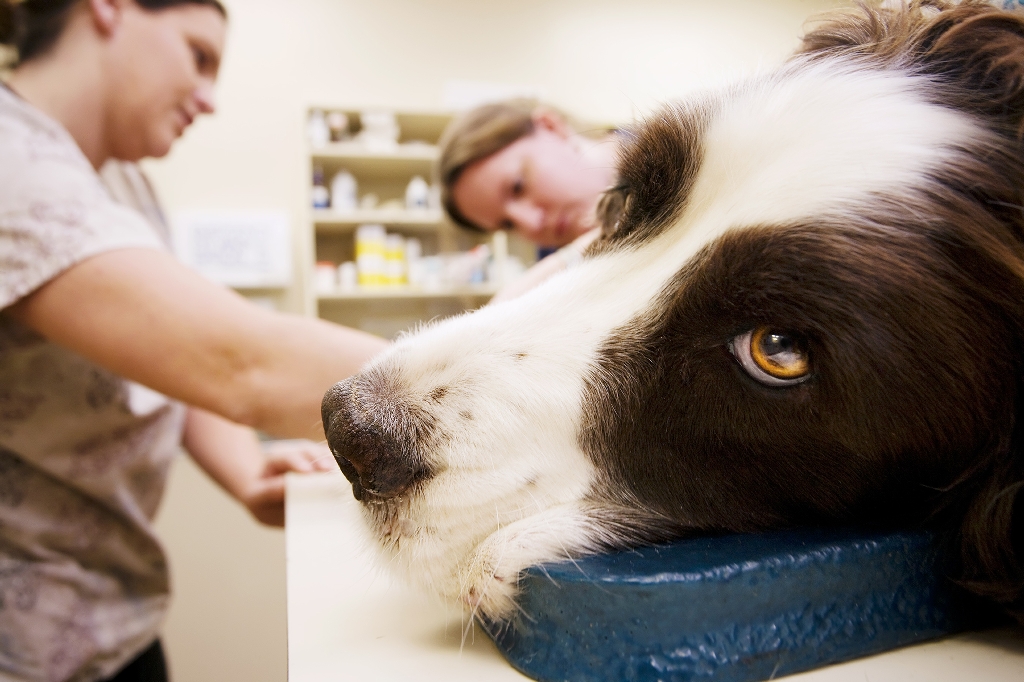For the record book, ideas I am about to share will be contrary to some of your opinions of what a veterinarian-centered practice should be doing. Some of the ideas will be contrary to your levels of trust. Some will walk away saying it can never happen on their watch. In short, many veterinarians CRINGE at the thought of sharing these ideas; that is called ‘university training’ and has proven to be short sighted in most other healthcare professions.
Think of a “high powered” dental practice, where you are booked to see a dental hygienist every six months. Next time you do, ask them to let you look at the appointment log. First item – over 85% of patients are prebooked (6 months out), with internet/text message automatic follow-up (only about 5% of veterinary practices are prebooking). The dentist may have 3 to 5 chairs scheduled for his restoration work, and depending in the practice, there may be 6 to 12 hygienist chairs, which also now do whitening. That makes 9 to 17 appointment columns per dentist. Sure, the hygienist columns only reflect about $180 to $260 per hour production potential, while the restoration chairs are producing $350 to $800 per hour for the dentist. In these ‘high powered’ dental offices, you will notice an administrator coordinating all the business activities. You should also note the extenders working the restoration chairs with the dentist, skilled at getting X-rays as well as molds of the teeth and arcades. Now think of your practice with one column per provider, minimal in-house referrals to nutritional advisors (now being called nutritional stewards), and NO scheduled dental follow-up (discharge nurse doing a 7-10 day consult for hygiene and nutritional concerns). Also ask yourself why have you been limited by the expensive “practice management business software”, which by the way, cannot even do the basic business formula of ‘Income minus Expense equals Profit”. Over 85% of the practices in Australia are paperless (thanks to RxWorks) and EZYVet (in the cloud, saving thousands of dollars on hardware) links traditional income-based software capabilities directly to Xero accounting software (also in the cloud), so the full income and expense picture is always available for interim or EOM EZYVet review, without the hardware expense so common in most USA software systems. And you pay how much for that set of limitations?
So today is may be the time many of you get to move the next level . . .
Take M-2-D Next Level
The ideas may make some of you cringe – you will cross your arms, lean back in your chair, and say “no way!” That is YOUR CHOICE. I have been in 2000+ practices, and will be sharing concepts that have worked in Australia, New Zealand, Japan, Canada, USA, UK, and Northern Europe. The CHOICE of which ideas will be yours and yours alone . . . but a word of caution: Never try to implement more than 3 new ideas at a time (within 1 month), and for best results, restrict them to one per practice zone at a time.
TEN TIPS & TRUISMS
#1. Share the Accountabilities. In any veterinary practice, there are more requirements than most people realize. I have watched veterinarians change their own light bulbs, open their own mail, snake their own toilets, and otherwise do jobs that reduce their income production potentials. While you may not be excited about sharing some of these accountability requirements, the simple fact is if you do not, they will all take you off line, and you lose $200-$400 an hour from outpatient and $300 to $700 an hour from inpatient production, if you let yourself get distracted with these accountabilities. You were trained to do them by the school of hard knocks (they were not academic subjects, nor are they journal worthy articles in most cases), so it is self-evident that you can train others to be proficient in any of them!
#2. Develop Program Managers. In my world, coordinators are the link pin in zone operations, they ‘coordinate the people’ in a practice zone (client relations, outpatient, inpatient, animal caretakers, etc.). Program managers are the ones that ‘coordinate things’ like inventory, dental care, behavior, immunizations, nutritional advisor, etc. As part of most consults, I share a functional staff volunteer list, with built-in resources, to start the Program Manager programs when you get back to your practice.
#3 – Written Standards of Care (SOC). Whenever a practice extends beyond one vet, a written standards of care is needed, this includes when a practice starts to empower their staff members to represent the practice’s core values, mission focus, and standards of patient care to clients. The AAHA Compliance Study showed that most practices were losing about $630,000 per vet per year by not being consistent in well care and preventive care practices. By writing the practice’s commitment to well care and preventive care in a single, easy to read document, everyone will become aware of the commitment required. The SOC should be the WHAT statements, not protocols and not lengthy WHY explanations – that is for staff meetings when programs are being introduced. Medical record reviews can then be conducted weekly to ensure compliance by each provider to the SOC elements. Every SOC NEED (never use the word ‘recommendation’) is followed by a X-A-D-W; X = do it; A = appoint it; D = defer it (needs until when date); or W = waiver, never mention it again. When doing the quarterly budget review, failure to reach target goals are assessed by individual program and individual provider commitment/compliance to expected SOCs (patient needs) and related booking rates for specific programs. And by the way, with a written SOC document, even the savvy owner should stop making exceptions for his old mates!
#4. Share thank you notes. When I was in practice, I had a box of thank you cards, blank inside, with practice specific covers, and scanned the local newspapers for reasons to send a hand-written personal thank you note to someone, whether they were a client or not; any community contribution was enough to get a thank you note! Many people will tell you they have every thank you note they’ve ever received during their professional career. Many practices post their thank you notes on a bulletin board or in a scrap book, but inversely, send out very few . . . that is a very interesting dual standard in my mind. If you ever have mailed a thank you note to a staff member at their home, with a real stamp and hand written envelop, for something they have done for the practice, the team, or yourself, you know the gratitude response first hand; the sad thing is many managers have never seen this gratitude because they have not reached out to say ‘Thank You’ in an unusual but memorable way. Thank you notes put a tangible and meaningful token of gratitude right in the hands of those who need it the most. Is there a staff member in your practice who makes a difference and for whom you are grateful? If so, take a few minutes to write him/her a thank you note, and BE SPECIFIC on the behavior you are accolading.
#5 – 2xFL – think two visits a year for life. Most every client knows that one dog year is 5 to 7 people years! Yes, we all realize that it is not that easy, but who cares when the client believes that simple ratio. Most practices have a predominant female client base, up to 70%, who already know they need to see their OB/GYN every two years at least, and their dental hygienist every 6 months. What would be the response if they told their OB/GYN, “See you in seven years doc!” . . . answer, ‘NOT HARDLY LADY!’ In most all surveys, clients say they don’t come back because no one made it important enough for them to revisit. It did not help that we taught clients to come only for vaccines, and charged prices so high that the wallet exsanguinations stopped vacations, movies, and even happy meals for the kids. Start planning the next visit, even if it is with a veterinary extender who is well versed in well care and FEAR FREE PHILOSOPY of practice (e.g., AAHA Certification Program).
#6 – Use the 4 Rs on every patient every time. The dentist schedules the next visit (6 months or sooner) before your leave the clinic. The pediatrician hands the young mom a handful of lab forms and schedules the next baby visit before the discharge is completed. Your physician should be setting up surveillance visits for your blood chemistries. Your car mechanic puts a tag on your windshield when to come back. The wife’s hair dresser schedules the next visit before she leaves the salon. Heck, even the dog groomer schedules the next visit as a matter of discharge planning. So why do vets NOT practice a similar planning technique? Answer, we were raised by wolves! Actually, we were raised by ambulatory veterinarians who had to deal with producers who put the pencil to the economics of every vet service, so they used the word ‘recommend’, and came only when called . . . until the days of herd health and recurring equine dental floats. Companion animal and equine clinicians need to ensure every patient is at least 2 of the 4 Rs as part of every discharge action: Revisit (make the appointment), Recall (expected telephone contact time), Remind (e-mail, SMS or snail mail promise), and Resolved (medical record entry on successful close out of cases).
#7. Hire for Attitude. This is NOT the seventh thing you need to do, it is the first thing to do when building an improved practice team. Resumes have become a creative writing art form, they cannot be trusted any more (HINT: always call every reference). In the text, Building The Successful Veterinary Practice: Innovation & Creativity (Volume 3), Blackwell/Wiley & Sons Publisher, there are interview check lists for most positions, with hints on what key words to listen for when assessing attitudes. In training, we talk about KSA-A: Knowledge, Skills, Attitude and Aptitude. Given a candidate with the right attitude, training the skills and knowledge becomes easier. When they seem to come with skills and/or knowledge, but do not have the aptitude or attitude, training is very difficult if not impossible. For every person departing the practice team, it is an opportunity to seek someone with the attitude and aptitude to fill a void or shortfall on the team – do not look for clones! In fact, in the VCI Signature Series monograph, Staff Orientation & Training (from the VIN bookstore, www.vin.com), there are self-directed training programs for empowering the staff members who have the right attitude and aptitude.
#8. Train to Trust. There is no “average” in healthcare skills or knowledge, no adequate, nothing that is the ‘fair’ or ‘good’ category of assessment. Competency is Excellence, there is no other grading system. Think of placing an I.V. – what is a “C” average, maybe going through both sides of the vein? Think of a femoral bleeder, spurting a one meter arc – what is a “C” average for stopping the bleeding, maybe a 10 cm arc (this still leads to a body bag)? Think of placing an anesthetic misadventure (what surgeons call an animal that stopped breathing while on the table) – what is a “C” average, maybe inflating the apical lobes only (this still leads to a body bag)? Think about “partial pregnancy” – there is no mid-ground, it is ALL or NOTHING in every case. In recurring performance evaluation assessments, why “grade” past performance instead of planning for the next 90 days? “Remember what you did last month – well don’t do that again!” does not build a proactive relationship, as opposed to, “What do you want to change, or learn, in the next 90 days?” The latter allows you to be a mentor, and share accolades while in route to the next level of exceptional performance. In fact, studies have shown annual reviews are worthless, and prospective quarterly performance planning is what works with the current generation of healthcare workers. In the VCI Signature Series monograph, Staff Performance Appraisals and Planning (from the VIN bookstore, www.vin.com), I provide individual forms for each zone in the practice, as well as manager and veterinarian forms and formats, for self-assessment and goal setting for the next 90-days.
#9. Understand the Power of the Human-Animal Bond (HAB). Interestingly, the ‘Human-Animal Bond’ terminology came into vogue with the Delta Society and Dr. Leo Bustad, back in the early 1980s. Then by 1990, the American Association of Human-Animal Bond Veterinarians (www.aahabv.org) was formed (only a $35 membership fee). I am a Charter member of both, as well as a past Board member of VetOne, a veterinarian-industry cooperative of the late 1990s. HAB spawned the bond-centered practice, which then became the client-centered practice, and is now the Pet-centered FEAR FREE practice. My most current FEAR FREE contribution is the VCI Signature Series monograph, Building the Bond-Centered Practice (from the VIN bookstore, www.vin.com), updated in 2013. Concurrently, my text, Promoting the Human-Animal Bond in Veterinary Practice is now in the Second Edition (circa 2009), with all 26 appendices (mostly staff plug-n-play type ideas) with the new well care chapter (entire text is only 250 pages); the good news is that it can be obtained for FREE – and you should be able to afford FREE. The book is posted in the VIN Library (www.vin.com) for FREE DOWNLOAD – it only takes a half ream of A4 paper.
#10. Become a Student of Leadership. I advocate being a continual student of leadership . . . a good leader must be able to manage, but a good manager may not have the slightest idea about leadership. I once had a CFO approach me and wanted to blame another Director for an operational shortfall, yet I would not participate in the “blame game”. She returned the next day as offered to take 20% of the blame, if I would support her effort in passing 80% of the blame to another Director, again I asked about ‘future think’ and would not play the “blame game”. On the third day, the CFO offered to take 60% of the blame if we could shift 40% to another Director; I again told her that if she wanted to work on future prevention, alternative solutions, or even reorganizations, I would participate, but I would not enter into the “blame game”. She never understood; she was “bean counter” to her core! In the 2000+ practices I have visited, I have learned something beneficial in every one, usually from a staff member. My first text was, Building The Successful Veterinary Practice: Leadership Tools (Volume 1), three of my Signature Series monographs specifically address various leadership aspects within a veterinary practice. I have written three separate leadership courses in three different countries, and in the 19 weeklong leadership courses that I have staffed or led, I have learned something about the inter-relationships of the leadership skills, and the inherent understanding of participants about the human nature leadership. In my text, The Practice Success Prescription: Team-based Veterinary Healthcare Delivery, available for FREE download from the VIN Library (www.vin.com), it comes together as an essential element for a cohesive veterinary practice development plan. In simplest terms, the WHAT and WHY must be shared by the leader as a new concept is shared and before a program can be moved forward. The WHO and HOW must come from the appropriate staff members working in the zones to be impacted. The last step before any implementation is determining the WHEN, a joint agreed upon set of milestones and success measurements. A good leader does not unilaterally change the target in the middle of an implantation effort. A manager will often take credit and give blame, but a true leader will take the blame and give credit to others. You can manage programs, yet you must lead people.
Listing ten tips and truisms may sound presumptuous, yet that is the topic often assigned me when speaking at Association conferences. My preference is to enter into the practice fray and assist a practice team and its leadership to assess the organizational behavior, work through the issues at hand, and move the practice to the next level – this is what tailored consulting is all about! It is not an overnight fix, nor can it be done by adding some gimmicks; most of us have tried that and found the choices wanting, and the apparent solutions unlasting. Any of the above tips should be tailored into your own practice philosophy, core values, and mission focus; they must become part of the ordinary and not be seen as passing “tests”.
Speaking of “tests”, I have included a self-assessment for PROFESSIONALISM as a leader in your workplace at the end of this article. Have fun!






